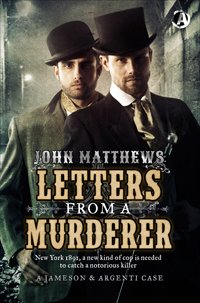If you’re interested in historical crime, whether fact or fiction, then John Matthews has produced a book with a fantastic conceit. The Jack the Ripper case was never solved. The murders of prostitutes in Victorian London’s East End just stopped and many thought that either the Ripper’s mania had left him, or he was dead. But what if he left the country? And what if he started again?
It’s New York in 1891, more than two years after the Ripper finished his infernal work in London. A prostitute has been found murdered and mutilated with an X marked onto her left shoulder.
Heading the investigation is the incompetent and corrupt Inspector McCluskey. Sir Thomas Colby, the criminologist unable to crack the case in London recommends his protégé Finley Jameson to assist. Jameson has been to New York to look after his poorly Aunt, and has stayed following her death.
Jameson has his own dark secret, visiting opium dens to lose himself in bizarre dreams. He is worried the blackouts he has been experiencing represent the onset of the same madness that sent his mother to bedlam. Taunting letters from the murderer hint that clues have been left in the form of characters from the Jewish alphabet which will reveal the killer’s identity. However, public alarm is rising, and the mayor has McCluskey replaced by Joseph Argenti. Argenti, the son of immigrants, has a reputation for being one of the few honest inspectors not in the pocket of the gangster Michael Tierney.
In turn, Tierney realises Argenti’s promotion will likely lead to an investigation of his prostitution ring, so he sets McCluskey firstly to sabotage the investigation, and when that fails, to murder. Jameson also comes onto Tierney’s radar as he develops a friendship with Ellie, one of the prostitutes, and begins teaching her to read. Later he begins introducing her to New York society.
The working class Argenti and the aristocratic Jameson are initially suspicious of each other. When Ellie is apparently attacked by the Ripper and Jameson suffers one of his blackouts in the vicinity of another slaying and is unable to account for his actions, Argenti’s suspicions grow. As the body count rises and the taunting letters stir panic, Argenti and Jameson have to put aside their animosity and learn to work together to solve the mystery of the murderer’s letters, and protect themselves from Tierney and McCluskey.
Letters from a Murderer shows all the signs that it will lead to a good series for Matthews. The milieu is fascinating and well described, and the two protagonists appear to have enough difference between them to develop an intriguing relationship where the sparks will sometimes fly. The author shows himself to be fully familiar with the necessary ingredients of a great thriller and knows when to build backstory and when to propel the story along. The police incursion into the sewers and the dockside finale are particular highlights. He even leaves us with somewhat of a cliffhanger as to the fate of the Ripper. There are points in the book where it could have done with some tighter editing and in the middle third the story sags a little – the Ripper’s detour to New Orleans being an example. Overall this is a satisfying book that stands comparison with the best recent examples of historical crime writing such as Sarah Pinborough’s Mayhem and Alex Grecian’s The Yard.
Osprey Publishing
Print
£3.33
CFL Rating: 4 Stars









